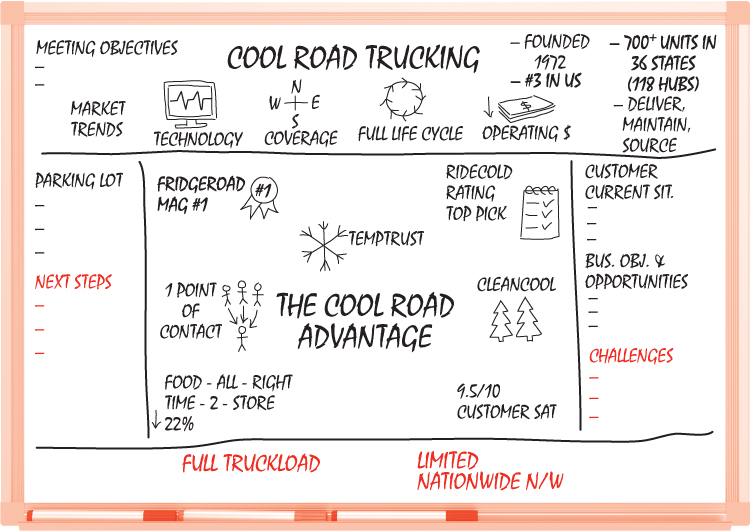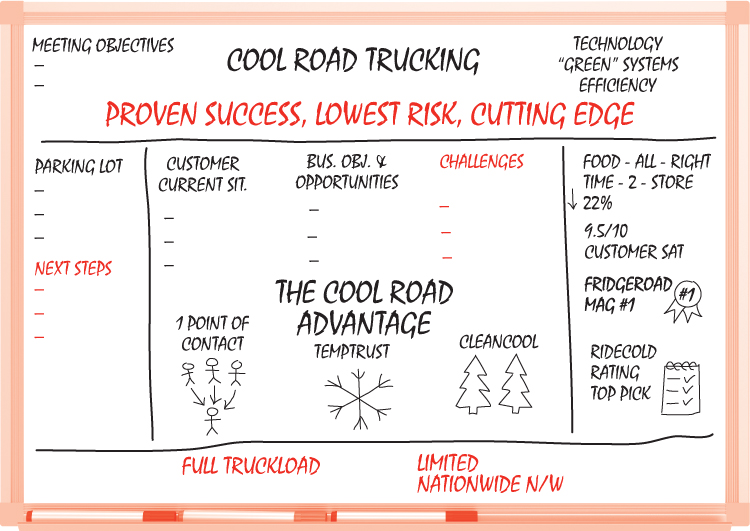
The fact that the message was built and flowed throughout, and built in a relevant way, made the content easier to internalize, easier to get a grasp on, and then easier for me to personalize going forward.
—Executive Strategist, systems management software company
When you read a book there are certain elements you rely on. There is the content of the book, the words, and the pictures. There is a table of contents that shows you the outline. The author has ordered the ideas, or the narrative, of the story so it makes sense. There is a visual design and layout that help you better understand the content.
A whiteboard for sales has similar elements. Each whiteboard you use during the sales process needs a predetermined structure you can use and then improvise on as needed, depending on how the sales meeting progresses. Each whiteboard dialogue has elements you can count on to help you communicate.
What are the elements of a whiteboard dialogue? One element is content—the words and visuals that communicate the unique value of whatever is being sold. Another element of the content is a script associated with each step of the whiteboard, which supports the visuals by providing a talk track. The script is designed to be an example of talking points only, not to be used verbatim by the presenter. The best practice is for the seller to customize the script according to the needs of each customer or prospect, leveraging the concept of situational fluency.
As with any story or narrative, a whiteboard for sales has a number of logical steps or break points in the content that act like sections and chapters in a book. These steps and break points make up the flow of the visual story.
Finally, every whiteboard designed for selling must include a number of key interaction points when, in addition to drawing and talking, the presenter pauses to engage with the customer or prospect.
There are three key types of interaction points:
In Part 4 we will look in depth at whiteboard content elements, but generally speaking various whiteboards for sales might include (in no particular order) the following 12 specific actions:
There are no hard and fast rules about the placement or ordering of the above elements on the whiteboard. Not every whiteboard for sales must include all, or even most, of the above ingredients. It all depends on the objective of the whiteboard.
In the following chapters you will see a variety of whiteboard template examples and learn details on how the above ingredients work in different whiteboard types.
Let's look at some examples of how to lay out some of the elements on a whiteboard or other drawing surface. You will see the positions of these elements change according to each whiteboard's type, purpose, and sales situation.

Look at the middle section of the whiteboard on the previous page. The number of ways you can lay out the center of the whiteboard, using visuals, text, and/or schematics, is limitless. You can choose the solution elements, third-party validation, proven success, and competitive weaknesses in whichever ways that will be most effective for a particular sales situation.
Let's look at another potential layout of a whiteboard:

The center part of this whiteboard is different from the last example.
You may have noticed that neither of these example layouts map to the specific whiteboard types we addressed in Chapter 9. The purpose of these whiteboards is simply to demonstrate how various whiteboard ingredients, or content, can be represented in different ways.
In later chapters we'll discuss best practices for how much content a whiteboard for sales should contain, and how to break it into separate steps.